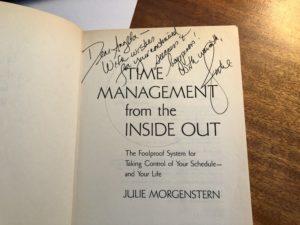 In this edition of the A to Z of Organising, I bring you 3 diverse T words.
In this edition of the A to Z of Organising, I bring you 3 diverse T words.
Teeth – Why on earth would teeth be listed in the A to Z of Organising? Because when I told my writing group friends I was writing about the letter T, they all started to tell me about their experiences with teeth. In particular, their children’s baby teeth. Some had held on to all of their now teenaged children’s teeth. Another had been gifted a beautiful silver container for storing baby teeth but never kept a single one. And it got me to thinking. Yes, I’ve worked with parents who kept their children’s teeth and then wondered if and how to declutter them. I’ve worked with a teenager who kept his teeth in a ziplock bag pinned to his noticeboard. In essence, teeth are just like any other form of memorabilia. I’ve also seen dried up umbilical cords, locks of hair, a full pony tail, along with concert tickets, matchbooks marking special events or locations, and birthday cards. With all memorabilia, I suggest that each person in the household have one container to store their memorabilia. The size of the container is up to them. What they choose to keep in that container is also up to them. Some people keep birthday cards. Some people keep teeth.
Tidy – There is a massive difference between tidy and organised. A tidy home can be disorganised. Imagine a beautiful living room with built-in cupboards. Nothing seems out of place. That is until you open those cupboards. Inside they’re crammed full of loose photos, wrapping paper, a few Christmas decorations, batteries (are they new or used?) and CDs out of their cases. Tidy but not organised. Can an organised home be untidy? I think so. Right now, as I write this, there is a jigsaw puzzle under construction on my dining table. The pieces waiting to be placed look untidy, but they’re organised into shape and colour groupings. There are half-read magazines on my coffee table. It doesn’t look tidy but they are exactly where I need them, ready to finish reading when I sit down for the evening. Likewise, there is a cross stitch project on the couch. The pattern, a pen to mark the pattern, a box of threads and the cloth are loose. If I tidied them away, I would be less inclined to get them out and start to work on that project. To me, that’s organised. So I invite you to notice the difference between tidy and organised, and choose the style that’s right for you and your clients.
Time Mapping – You probably expected to see Time Management in the A to Z of Organising, but what about Time Mapping? Time Mapping is an initial first step to taking control of time management. So, what is it? It starts with simply and objectively recording how you spend your days, warts and all. I recommend recording a two-week period, and obviously a typical week, not a week that’s troubled with illness or blessed with a holiday. Record every action and how long it takes. The morning walk, as well as the hitting the snooze button. The drive to work as well as the coffee break. The client session as well as the report writing and invoicing afterwards. Now, after those two weeks, take a birds’ eye view of that “map” of how you currently spend your time. It may help to colour code it. One colour for personal time, another for family time, another for work time, etc. What do you notice? What are the patterns? Are there chunks of time which could be reallocated to a more convenient or productive time of the day or week? Where could you make efficient changes? Taking control of the time map is the final and most fun part. Create a new time map which works for you and with your strengths and preferences. That is known as Time Blocking. I first learned about Time Mapping from Julie Morgenstern’s book, Time Management from the Inside Out, and I’m thrilled to have my very own signed copy of that book on my shelf.
To read about the rest of the A to Z of Organising so far, click here.



